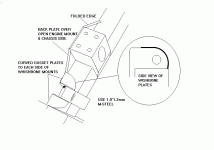I've replaced all of those parts, with the exception of the inner rear fender panels, and much more, including crossmembers and ourtriggers. Rather than a specific sequence, let me give you a few lessons. First, you are probably going to find more rust rot than you expect, assuming that you have not yet removed the old metal. As and before you start removing old stuff, check very carefully for rot that now may be hidden. This is especially true around the outriggers, where they attach to the frame rails. If you are lucky, you indeed will have to replace only those items you listed. If not, and you have to replace or repair frame and outrigger pieces, the job gets much more complicated.
Assuming the best,however, I would replace the sills and rear dog legs first, as the floor pans attach to the sills, as do the rockers, the shut faces and the rear dog legs. But before removing these items, I would check your door fit. If it's ok, then fabricate bracing to maintain door opening measurements during the process. Cut out as little as possible at a time, because each part helps maintain the shape and alignment of the entire assembly. After the sills, dog legs and shut faces are in, I'd relpace the pans and footwell panels. If you're lucky, the footwells and floor panels have attachment nuts and bolts for the insulation and exhaust pre-welded. If not, measure and attach these items first, before installing. The rockers are probably the last thing to attach, and for my money the hardest. For one, they can't be spot welded to the sills, so you have to simulate spot welds, or seam weld. The sills are thin, can't be really clamped well to the rockers, and will warp if you are not very careful, and a good welder. But if your car is fully laden, on its suspension, with engine and transmission, with the doors hung and adjusted, with windows in, or about 15 lbs for substitute weight, you can align and clamp the rockers with the appropriate gap for the doors. I would even suggest temporarily fitting the aluminum trim pieces to ensure proper spacing. I know this is a lot, but what you're talking about is a big job. My chassis restoration took me over a year. Hindsight makes the Jule chassis look great. One more tip: After I finished the re-work on the chassis, I reassembled the car with all drive train and all exterior body panels, and took the whole thing to the body shop, where they aligned all panels with the chassis. After that, I disassembled the whole thing again, and took the chassis to the same body shop for chassis prep (including extensive seam sealing) and paint. That should be done any day now. My next step is to assemble a restored rolling chassis, strip all body panels, and return the whole package to the same body shop for final paint. The trick on these cars is getting the body panels aligned properly. With all the welding you are going to do, whether you will have all the panels align afterwards is anybody's guess. Hope this helps.

 Hey there Guest!
Hey there Guest!
 smilie in place of the real @
smilie in place of the real @
 Pretty Please - add it to our Events forum(s) and add to the calendar! >>
Pretty Please - add it to our Events forum(s) and add to the calendar! >> 



 A friendly reminder - be careful what links you click on here. If a link is posted by someone you don't know, or the URL looks fishy, DON'T CLICK. Spammers sometimes post links that lead to sites that can infect your computer, so be mindful what you click.
A friendly reminder - be careful what links you click on here. If a link is posted by someone you don't know, or the URL looks fishy, DON'T CLICK. Spammers sometimes post links that lead to sites that can infect your computer, so be mindful what you click.